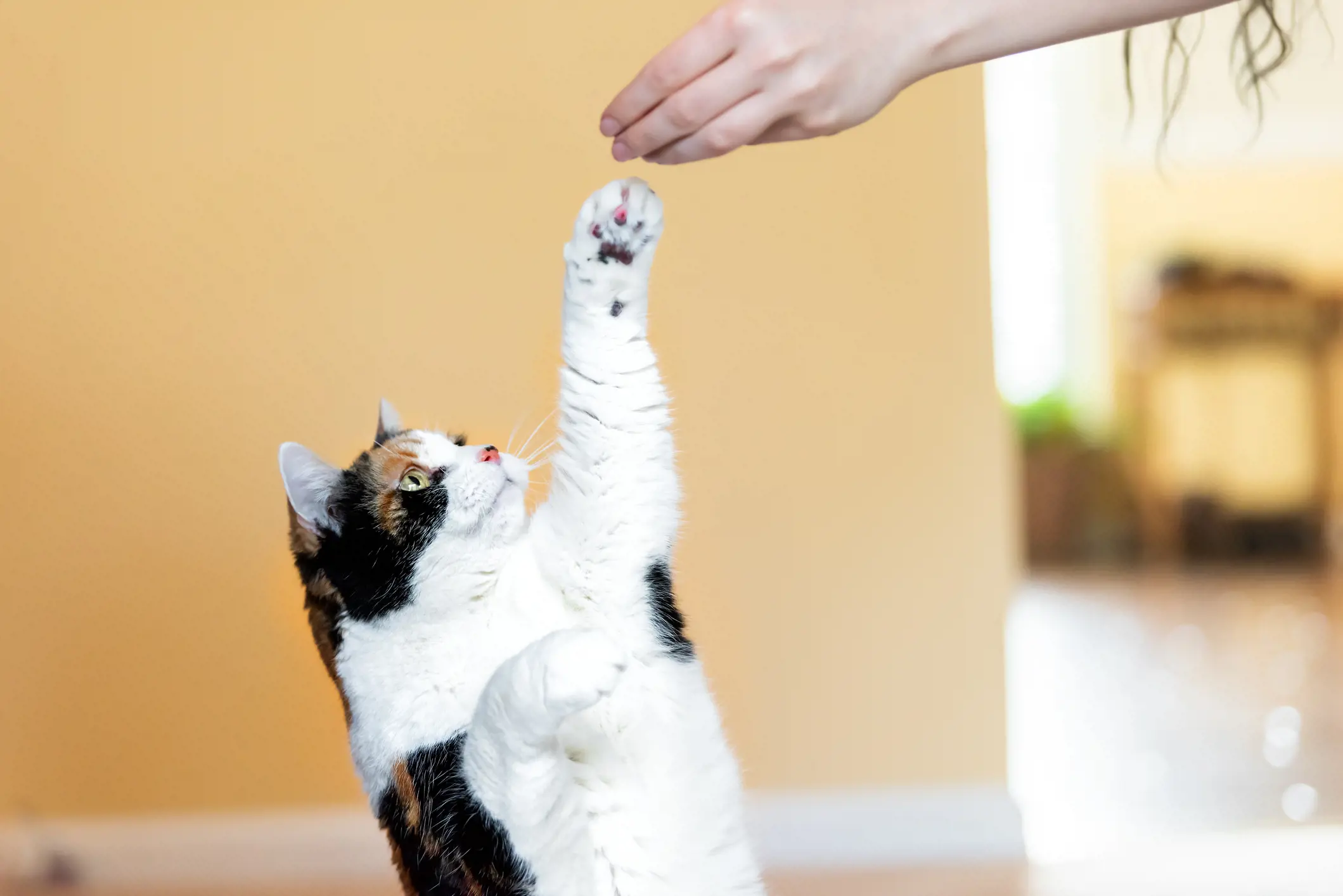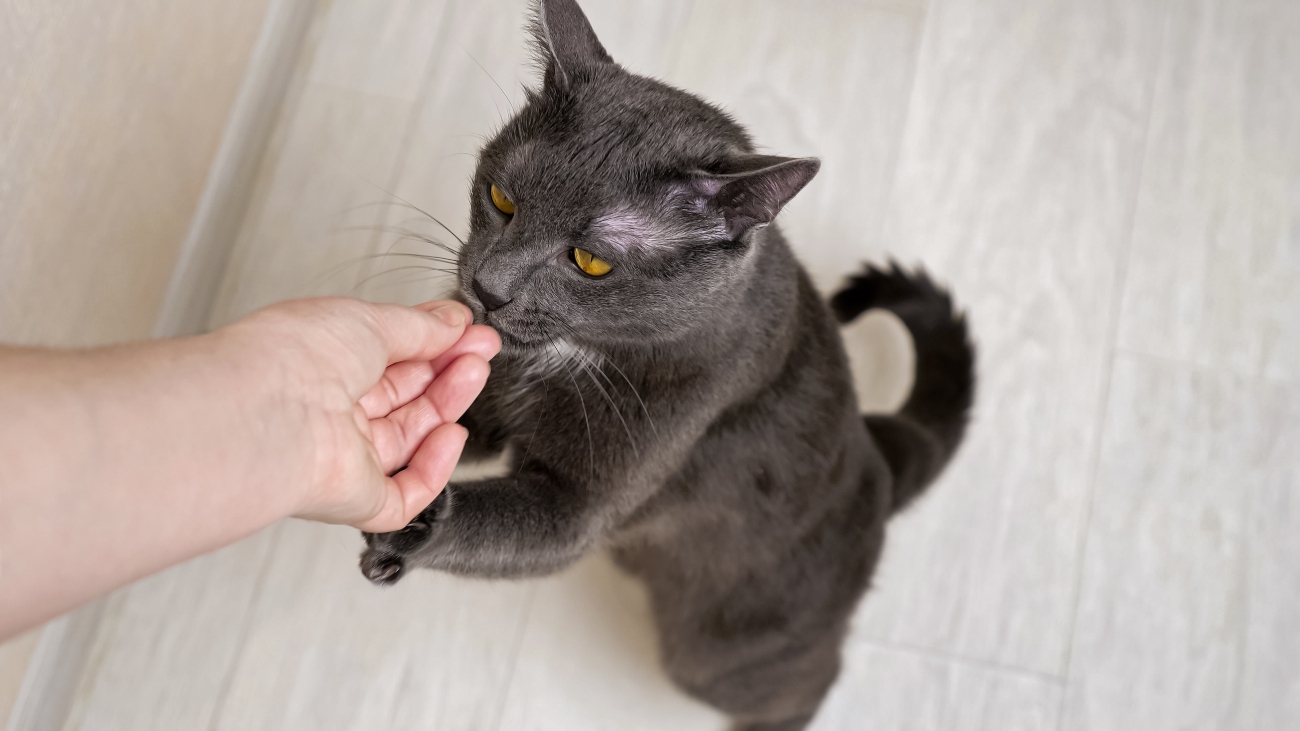How to train a cat
27th January, 2022

While we usually associate training with our four-legged canine friends, you can teach your cat a few tricks, too. That is, if you show some patience and follow the Purely Pets ‘How to’ guide for training a cat.
Hopefully you won’t experience any training mishaps! But if you do, our cat insurance can protect your feline friend from illness and injury.

What do we mean by cat training?
Okay, let’s not get ahead of ourselves here. If you’re looking for your cat to meow Happy Birthday or bring you slippers when you return from work then you’re going to be sadly disappointed. However, don’t despair, training your cat can still be useful in lots of practical ways.
Basic cat training can include:
- Teaching them to recognise their name.
- Toilet training.
- Encouraging them to accept a cat carrier.
- Getting them used to being handled for basic health checks.
Indeed, they may even become happier about having their ears checked because they are anticipating a tasty treat!
If possible, to help your pet pick up these skills it's important to begin training from an early age. As well as being more successful, it will also have the added bonus of giving you both the opportunity to interact in a positive and productive way. The perfect way to stimulate your cat and strengthen the bond between pet and owner.
Remember not to be too hard on yourself if they don’t immediately pick things up. Any time your cat learns to do something based on your behaviour, you are in effect training or teaching them.
How to train your cat – getting started
In general, by far the best way to get your cat to do something is by offering them a reward for doing what you’ve asked. Often called ‘positive reinforcement’, the more your cat feels happy and comfortable about doing something you want them to do, the more likely they are to do it.
However, this means that the most effective training will have to take place gradually over time. Follow some of these top tips to help make training a breeze.
- Think about what it is you would like them to do, then try to break this down into small steps, and slowly work through these together with your furry friend. For example, perhaps you’re teaching your cat to tolerate their cat carrier? You might first simply reward them for looking at the carrier. Then reward them for walking towards it or even just sniffing it. And so on, until they’re happy to sit inside with the door closed.
- Make sure your cat has mastered one skill before trying to move on to another. A cat can quickly become overwhelmed if you’re asking too much, too soon.
- Using a spoken cue word or clicker is a good way to teach them to associate the word or sound with a reward. Meaning they’re more likely to perform that task again in the future when they hear it.
- Provide the reward as soon as possible after they’ve done as you asked. If you leave it too long, then the cat is unlikely to associate the reward with the behaviour you want. Over time you should be able to leave a longer gap.
- Cats aren’t as interested as dogs in pleasing us. So usually food rewards work better than verbal or physical praise. That said, many cats can also be rewarded by stroking or being given access to a toy. It’s up to you to work out what works best for your feline.
- If you’re using food as a reward then training them before mealtimes is likely to prove more successful. After all, a food reward won't be so enticing on a full stomach! That said, if the cat is hungry then they may quickly lose patience with training!
- Keep sessions short and sweet. Always finish before your cat gets bored or tired. A 10-minute session is perfect.
- Choose a quiet time. Background noise from TVs, dishwashers, or vacuum cleaners won’t help your cat stay concentrated.
- Try to stay consistent. If possible, use the same signals and rewards. Inconsistent or sporadic training sessions won’t get you the results you want!
- Be patient. Training a cat is not an overnight fix. Keep everyone motivated with lots of positive praise and rewards for good behaviour.
- Avoid feeding them treats from your hand. Instead place the treats on the floor near to you. That way you’ll avoid accidental bites or scratches.
- If your cat does something wrong, never punish them. A firm ‘no’ before directing them to something else is the best way to deal with this. Punishing a cat is likely to make them more anxious or frustrated. Indeed, the experts at Battersea say punishing a cat will probably make the problem even worse.

Cat training tricks to try out today
Come when called
This is the most useful ‘trick’ you can teach them – particularly if they’re an outdoor cat. Start off by shaking a cup of treats while calling their name.
Reward them every time they come to you and they’ll soon make the link between their name and a tasty treat. Eventually you can move away from treats to simple praise and strokes.
Sit
Sometimes you might need your cat to stay in one place for at least a little while. And this trick will help with that. Because this trick is slightly more difficult than ‘Come’ it’s good to add in a hand signal and a clicker to reinforce the learning.
Simply position yourself in front of your cat with your ever-helpful cup of treats and a clicker. Now say ‘Sit’ in a calm voice and hold your hand vertically in a stop sign.
Every time your cat sits on your command, reward them and click the clicker. Over time use the clicker and treats more occasionally.
The great thing is this learning process can then be used to teach them a whole range of other cute and cool tricks. Riding on a skateboard anyone?
In the carrier
Cats love exploring bags and boxes but when it comes to cat carriers, not so much. This is because they’ve learned to associate them with a negative experience such as being trapped or taken for a medical check-up in an unfamiliar place.
Wood Green, the animal charity, has an excellent step-by-step article for teaching your act to accept being in a carrier. As you can imagine, it involves plenty of patience, a quiet and calm environment and plenty of treats!
High five
According to the Blue Cross animal charity, teaching your cat to give you a high five or even shake your hand is a lot simpler than it seems. And it’s a sure-fire way to get involved in the world of internet cat memes.
Start off by encouraging them with treats to bring their paw off the ground. Next, hold the treat in your fist and wait for them to grab it with their paw. Treat them when they do.
The next step is to start lifting your hand higher. Keep rewarding them every time they touch your hand with their paw. And don't forget to say ‘hive five’ or ‘shake paw’ when you’re training them. In no time at all your cool cat will be giving you a regular high five greeting!
Many of these tricks can be used as the basis for other training, provided you’re prepared to take it slow and your feline friend is happy. It’s surprising at how many new tricks your cat can learn with a bit of patience. And a pocket full of treats!

Training your cat not to do something
There are lots of videos on the internet of owners teaching their adorable pets some pretty cool tricks. Just take a look at Kaiser the Bengal if you don’t believe us!
However, sometimes we actually want to teach them not to do something. The very best way is to first work out why your cat is doing something you don’t want.
And then give them an alternative. Here are some common complaints about cat behaviour, the reasons for them and what you can teach them instead.
Waking you up
Why?
Providing they’ve got ample food and water, a clean litter box and a warm place to sleep then it might be they’re simply looking for some attention.
Answer
Invest in some puzzle feeders or interactive toys to keep them entertained at night. Allow them access to the garden and ensure you’ve spent quality time with them before bed.
Scratching furniture
Why?
Do they have suitable places indoors and outdoors to scratch? Cats often scratch if they feel like their territory is under threat from another cat.
Answer
Provide lots of attractive scratching alternatives. Many people own more than one cat. If you do, then make sure they’re still getting along. If possible, try putting something in the way to restrict your cat’s access to the area.
Inappropriate toileting
Why?
There can be many reasons behind this difficult cat behaviour. Is the litter tray cleaned regularly and in an appropriate place? Could another cat be blocking access to the tray? If a cat is feeling stressed or unwell then this can be a common cause of toileting problems.
Answer
Check the tray is clean, appropriate for them and in a good location. If you have more than one cat in the house, are they getting on well? Is it worth booking in for a check-up at the vet?
Having cat insurance is a big part of making sure your cat stays healthy throughout their life with you. Read our recent article on common cat toilet problems to get more insight.
Aggression when stroking
Why?
Not all cats are as happy about close human attention as others. So always make sure they are enjoying you touching them. If they’re not, they might be in pain so it’s best to get it checked out.
Answer
Being aware of your cat’s normal behaviour and body language is a key part of being a caring owner. Stopping before your cat demonstrates aggression is important.
If you don’t, you may end up reinforcing the aggressive behaviour. A cat will soon learn that biting and scratching is the best way to get you to stop.
Take a look at our advice on why cat’s bite and how to read their body language for more information.
Sometimes a cat may just be bored and wanting to ‘play’ with your hand. Providing your cat with a stimulating home environment is a good way to reduce this rough stuff.
Take a look at our advice on how to create a pet-friendly garden and enrichment ideas for indoor cats.
Get a cat insurance quote with Purely Pets
Whether your cat loves playing fetch or refuses to respond to their name, they’ll provide you with wonderful companionship throughout their life with you.
To make sure they always receive the very best care it’s vital to arrange the most appropriate insurance cover. The dedicated team at Purely Pets work hard to secure cover to suit all budgets and the needs of both cats and their owners.
Whatever the problem, if you’ve taken out award-winning cat insurance through Purely Pets, you’ll get cover for vet fees from £1,000 to £15,000 per year. You can even choose an excess level starting from just £60.
Our caring team of insurance specialists have designed 15 levels of lifetime cover so you can easily decide what’s right for you, your cat, and your budget.
Many policies can also give you added benefits such as cover for dentistry if your policy has been active for more than a year, loss of a pet, third party liability and overseas travel. Our useful online policy management portal provides you with the flexibility to manage your policy whenever you want.
We can provide an online quote within minutes. And our 24-Hour Vet Helpline is on hand if you have any health-related questions about your cat.
Get a quick quote for cat insurance from Purely Pets today.
Helpful Pages
Recent Posts
Pet Insurance Quote
- 98% claims paid *
- Claims paid directly to vets
- 24/7 vet video consultations
- Interest free monthly payments




